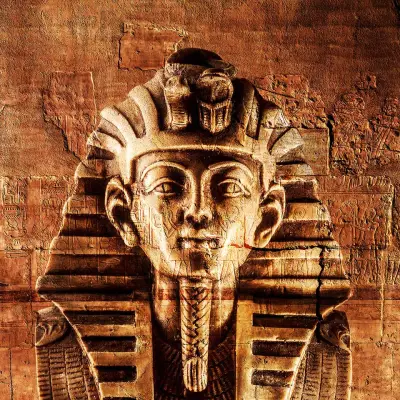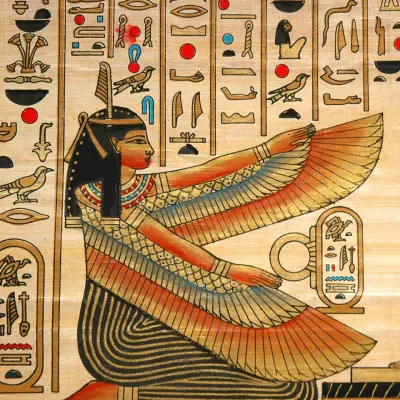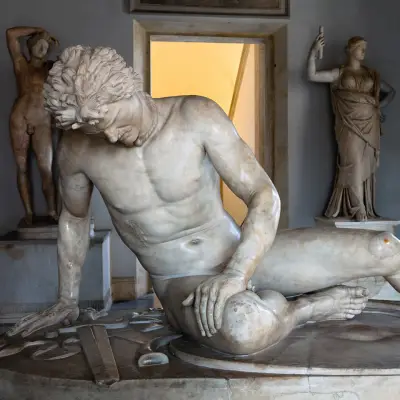Japanese mythology is filled with fascinating figures who represent everything from the beauty of the sun to the chaos of storms. If you've found yourself intrigued by tales of divine tempers, heroic battles, and symbolic meanings, then Susanoo-no-Mikoto is a figure you'll want to know more about. Let’s explore his myths, powers, and symbols in this blog post.
Jump to:
- Who Is Susanoo in Japanese Mythology?
- Susanoo’s Myths
- The Role of Susanoo in Japanese Storytelling
- What Powers Did Susanoo Possess?
- Symbols Associated with Susanoo
- Susanoo’s Lineage and Connections
- Why Is Susanoo Special?
- Susanoo in Modern Culture
- Susanoo’s Worship and Legacy
- Frequently Asked Questions About Susanoo
- Study Japanese Mythology for £29
Recommended for you!
Best SellersWho Is Susanoo in Japanese Mythology?
Susanoo-no-Mikoto, often shortened to Susanoo, is a major deity in Shinto, the traditional religion of Japan. Known as the storm god, Susanoo’s domain lies in the wild forces of nature, particularly the sea and wind.
Susanoo is also known for his fiery personality, which often caused conflict with other deities, especially his sister Amaterasu, the sun goddess. His emotional outbursts and rebellious spirit have made him one of the most dynamic characters in Japanese mythology.
Susanoo’s Myths

Susanoo is one of the most vividly portrayed deities in Japanese mythology, with stories that reveal both his wild nature and his capacity for heroism. His myths range from reckless acts in the heavens to daring rescues and the founding of earthly clans.
The Banishment from Heaven
One of the most well-known tales in mythology is his banishment from the heavenly realm of Takamagahara. His unruly behaviour, such as destroying rice fields, defiling sacred grounds, and throwing animal corpses into divine halls, led to his exile.
His impulsive and destructive nature became too much for the other Japanese gods to handle. His actions also deeply offended his sister Amaterasu, causing her to retreat into a cave and plunge the world into darkness.
The Slaying of Yamata-no-Orochi
After his banishment, Susanoo descended to the earthly realm of Izumo. There, he encountered an elderly couple weeping over their last remaining daughter, Kushinada-hime, who was to be sacrificed to a monstrous eight-headed serpent called Yamata-no-Orochi.
Susanoo agreed to help in exchange for Kushinada-hime’s hand in marriage. Using his cunning, he intoxicated the serpent with sake and then cut it into pieces, discovering the legendary sword Kusanagi-no-Tsurugi in one of its tails.
Founding a New Life in Izumo
Following his victory over the serpent, Susanoo settled in Izumo with Kushinada-hime and began a new chapter of his life. He built a palace and took on the role of a local guardian deity, known for protecting the people and their lands.
This myth shows a transformation in Susanoo’s character, from a god of chaos to a protector and founder of noble bloodlines. His descendants were said to include the rulers of Japan, linking him to imperial lineage and the continuation of divine favour.
The Role of Susanoo in Japanese Storytelling
Susanoo is often portrayed as a misunderstood hero; a powerful figure who struggles with his emotions but ultimately chooses to do good. This dual nature makes him a key character in many traditional stories, where he often plays the role of a disruptive yet necessary force. His ability to shift from chaos to courage reflects the natural world's unpredictable power, which the Japanese people both feared and respected.
In folklore, Susanoo represents the concept that disorder is sometimes essential to achieve balance. His actions, while troubling at times, often lead to renewal or protection, such as when he slays Yamata-no-Orochi and brings peace to the land.
What Powers Did Susanoo Possess?

Susanoo's powers are dynamic and intense, reflecting his role as the god of storms, seas, and transformation. Unlike his sister Amaterasu, whose influence is steady and luminous, Susanoo embodies the raw, unpredictable forces of nature, capable of both destruction and renewal.
- Control Over Storms and the Sea: As the Susanoo god of storms and oceans, he commands fierce winds, crashing waves, and turbulent weather. These forces could devastate or cleanse, showing his dual nature.
- Combat and Bravery: Susanoo is a fierce warrior, famously slaying the eight-headed serpent Yamata-no-Orochi with strategy and strength. His fighting spirit and tactical mind earned him great respect among the gods.
- Magical and Sacred Tools: He discovered the legendary sword Kusanagi-no-Tsurugi within the serpent’s tail, a powerful weapon later passed to the Imperial line. This symbolises his connection to divine artefacts and protection.
- Shape-Shifting and Illusion: Some legends suggest Susanoo could change form or influence the physical world through magical means, especially in interactions with spirits and monsters.
- Purification and Renewal: Despite his chaotic tendencies, Susanoo also plays a role in cleansing, both spiritually and physically. His expulsion from heaven symbolised the removal of disorder, and his later deeds bring restoration and peace.
Symbols Associated with Susanoo

Symbols of Susanoo reflect his wild energy, his heroic deeds, and his complex relationship with nature and divine law. They often appear in rituals and shrines dedicated to him across Japan, especially in coastal and agricultural communities.
- Kusanagi-no-Tsurugi (Grass-Cutting Sword): This sacred sword was found inside Yamata-no-Orochi and symbolises strength, divine right, and the power to overcome great obstacles. It’s one of the Three Sacred Treasures of Japan.
- Storm Clouds and Waves: Representing his dominion over weather and water, these motifs express both danger and the life-giving power of the sea.
- Serpents and Dragons: Inspired by his battle with the eight-headed Yamata-no-Orochi, these creatures symbolise the challenges he overcame and the primal forces he mastered.
- The Susa Shrine and Izumo Region: Locations tied to Susanoo’s earthly journey and marriage to Kushinada-hime, representing his transformation from chaos to stability.
- Animals Like Horses: Often associated with Susanoo in rituals, horses are considered sacred messengers and offerings in his honour.
- The Colours Blue, Black, and Silver: These tones reflect Susanoo’s deep connection to the ocean, the night sky, and his stormy temperament: blue for water, black for mystery and power, and silver for the sword and celestial strength.
Susanoo’s Lineage and Connections
Susanoo-no-Mikoto is the son of Izanagi, the creator god who formed the islands of Japan and gave birth to many of its deities. As a direct offspring of this powerful figure, Susanoo holds a significant place within the Shinto pantheon.
He is the brother of Amaterasu, the sun goddess, and Tsukuyomi, the moon god. The stormy relationship between Susanoo and Amaterasu plays a major role in Susanoo mythology, influencing several of the most well-known myths in Japanese tradition.
Unlike Amaterasu, Susanoo did take a wife, Kushinada-hime, after saving her from the serpent Yamata-no-Orochi. Their union is said to have led to the founding of noble bloodlines, including descendants who became linked to the early rulers of Japan.
Why Is Susanoo Special?
Susanoo stands out because of his complexity. He’s not a simple hero or a villain. He reflects the wildness of nature and the emotional struggles that people can relate to. His story is about transformation, redemption, and the power of choice.
Susanoo in Modern Culture
Today, Susanoo remains a powerful and respected figure in both religious tradition and popular culture. In modern Shinto practice, he’s still worshipped at significant shrines such as Susa Shrine in Shimane Prefecture and Yasaka Shrine in Kyoto, where rituals honour his strength, courage, and protective nature. His energy is also embraced in contemporary spiritual settings, where he is seen as a symbol of transformation, protection, and emotional release.
Those who feel connected to Susanoo may include ocean imagery, storm motifs, or powerful symbols like the serpent or sacred sword in altars or meditations focusing on inner strength and renewal.
Outside of traditional worship, Susanoo’s mythology has been widely reinterpreted in modern media. In anime series like Naruto, the name Susanoo is given to a giant ethereal warrior formed from chakra, representing protection and power, though this depiction is a symbolic borrowing rather than a direct reference to the Shinto deity.
He also features in video games such as Smite, where gods from different mythologies are reimagined for combat gameplay, and occasionally in Japanese RPGs and manga, where he appears as a warrior figure or storm deity. These modern portrayals often highlight his tempestuous nature, his warrior role, and his connection to legendary weapons, particularly the sword Kusanagi.
In contemporary art and storytelling, Susanoo is often shown as a brooding but noble figure, cloaked in sea spray or lightning, with strong ties to nature’s raw and emotional forces. His story resonates with themes of redemption, bravery, and the harnessing of one’s inner storms, offering creative inspiration for narratives of personal growth and transformation.
Susanoo’s Worship and Legacy

For those who wish to honour Susanoo, there are many ways to engage with his spirit and symbolism. Spending time near the sea or during a storm can be seen as connecting with his energy, as can meditating on themes of courage, protection, and renewal. Offerings might include sake, water, salt, or items representing storms, waves, or sacred blades—symbols of purification, power, and resilience.
Creating a sacred space decorated with ocean colours, serpent imagery, or references to his epic battle with Yamata-no-Orochi can serve as a grounding point for rituals or personal reflection. While the grand Shinto ceremonies held in his name are carried out at historic shrines by priests, many find personal meaning in honouring him as a guardian against harm, a symbol of emotional strength, and a divine force that clears away chaos.
His legacy endures in Japanese cultural identity, through stories that portray him as both a fierce protector and a redeemer. He continues to be a source of strength for those facing inner conflict, offering the reminder that even the most turbulent spirits can find purpose, peace, and power in transformation.
Recommended for you!
Best SellersFrequently Asked Questions About Susanoo
Is Susanoo and Raijin the same?
No, they are different deities. Raijin is the god of thunder and lightning, while Susanoo governs storms and the sea. Their domains may overlap, but their identities and stories are distinct. Raijin is typically associated with drumming up storms, whereas Susanoo’s influence is broader, including sea voyages and natural chaos.
Who is Susanoo based on?
Susanoo is a mythological creation, not based on a historical figure. He emerges from early Shinto beliefs as a symbolic representation of nature’s wild and untamed power.
Is Susanoo Yin or Yang?
He leans more toward Yin qualities, such as unpredictability and emotion, but the label doesn’t fully apply in Shinto belief. Instead, Susanoo’s nature is more fluid, shifting between chaos and protection depending on the tale.
Who is the wife of Susanoo?
Susanoo’s wife is Kushinada-hime, whom he saves from the serpent Yamata-no-Orochi. Their union symbolises a shift from wildness to harmony, as Susanoo settles into a more peaceful role after their marriage.
What animal is associated with Susanoo?
While not fixed, horses often appear in stories and rituals related to him. In some contexts, they are offered as sacred gifts or symbols of divine will, reflecting Susanoo’s connection to spiritual traditions.
Who created Susanoo?
Susanoo was born from the nose of Izanagi during a purification ritual. This birth story signifies his elemental ties to air and moisture, elements often present in storms.
Study Japanese Mythology for £29
Interested in exploring more about ancient Japanese beliefs, traditions, and divine figures like Susanoo? The Introduction to Japanese History and Culture Diploma Course from Centre of Excellence is the perfect place to start. For a discounted price of £29, you'll learn about he spiritual stories, practices, and philosophies that shaped Japan’s past and continue to influence it today.












